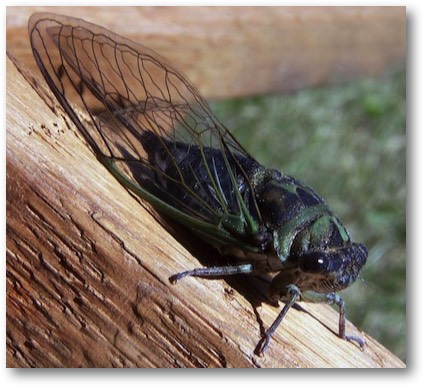866-295-4143, fbns@wayoflife.org

Cicadas have often been confused with locusts, but they are a different creature.
The adult cicada are large insects with black head, thorax, and abdomen, small antennae, large compound red eyes, three simple eyes, six sets of legs, and two sets of transparent wings with bright orange veins. They are about two inches long. Microscopic analysis has found that the wings are covered with minute spikes and chemicals that create a water-repellent film that removes dirt, keeps their wings dry, and also kills bacteria by literally tearing them apart as they are moved across the wing ("Biophysical Model of Bacterial Cell Interactions,” Biophysical Journal, Feb. 2013). Scientists are trying to replicate the design of the cicada wing for a new generation of rain jackets and for bacteria control (“Cicada-inspired waterproof surfaces closer to reality,” Illinois News Bureau, Oc. 22, 2020).
The cicada has a life cycle of three stages: egg, nymph, and adult. It is a dramatic process of metamorphosis, as with butterflies and some other insects.
The Magicicada nymphs are developmentally synchronized and emerge in great numbers from underground exactly on time in the spring of the 13th or 17th year, depending on the brood. It has been estimated that there can be more than 1.5 million insects per acre (Williams, Smith, and Stephen, “Emergence of 13-year periodical cicadas,” Ecology, 1993).
During the brief mating season, they make a huge racket by means of drum-like tymbals on each side of the abdomen. The tymbal is made of resilin and when buckled by the insect’s muscle, it unbuckles automatically when the muscle is relaxed. The male’s abdomen is nearly hollow and acts as a resonating chamber for the tymbals. Each species produces its own distinctive mating songs by modulating the clicks. The female detects the male’s signals by means of a membranous structure called tympana. Males also have tympana, and when signaling with their tymbals the tympana are disabled so as not to be deafened.
Thousands of mating adult cicadas make a noise that is nearly deafening. The Australian species can produce sounds up to 120 dB, the loudest of all insects. The ones in North America have been measured at 106 dB, which is like standing near a chainsaw. William Bradford, governor of Plymouth Colony, wrote the first known account of this in 1633. He said the insects “made such a constant yelling noise as made the woods ring of them, and ready to deafen the hearers” (Bradford’s History of Plymouth Plantation, 1606-1646).
After mating, the females cut slits on bark or branches and deposit their eggs (600 or more in batches of 10 to 20). Both males and females die within two to six weeks of emerging from the soil, thus ending the life cycle that began so many years before.
When the eggs hatch after about 6 weeks, the nymphs drop to the ground and burrow into holes, disappearing for 13 to 17 years, depending on the brood. (Other species of cicadas emerge in two to five years.) The nymphs have strong front legs for digging. They drink sap from tree roots and go through five stages of development called molting, each time shedding their exoskeletons for new ones. As they grow, they dig deeper into the ground to find new roots, tunneling as much as eight feet or more. In addition to sustenance from root juice, they are dependent on three types of symbiotic bacteria called Hodgkinia that provide essential vitamins and nutrients (“Feeding ecology and evidence for amino acid synthesis,” Journal of Insect Physiology, 2011, 57, p. 211-219). All three types of bacteria must be present.
In the spring of the pre-programmed emergent year, the nymphs dig tunnels to the surface and wait for the right time to emerge, which is when the soil a few inches deep reaches about 64 degrees F.
After emergence they climb a tree and make a final molt of their exoskeleton to complete the transformation into adults. At first their wings are soft and useless and they must wait about six days to complete the hardening of their wings and bodies. The males then congregate in “chorus centers” on shrubs and trees to call the females.
In his “Garden Book,” Thomas Jefferson recorded 17-year cicadas emerging in 1724, 1741, 1758, and 1775.
Fifteen broods of Magicicada have been identified, each brood emerging after a 13 or 17 year cycle. Brood X, a 17-year brood, emerged in the spring of 2021 across 14 states, and I witnessed this at the Meadowlark Botanical Garden in Virginia in June. If Jesus tarries, Brood X will reappear in 2038. In 2024, two broods are set to emerge: Brood XIX, a 13-year brood, and Brood XIII, a 17-year brood.
- Receive these reports by email
- www.wayoflife.org
______________________
Sharing Policy: Much of our material is available for free, such as the hundreds of articles at the Way of Life web site. Other items we sell to help fund our expensive literature and foreign church planting ministries. Way of Life's content falls into two categories: sharable and non-sharable. Things that we encourage you to share include the audio sermons, O Timothy magazine, FBIS articles, and the free eVideos and free eBooks. You are welcome to make copies of these at your own expense and share them with friends and family. You may also post parts of reports and/or entire reports to websites, blogs, etc as long as you give proper credit (citation). A link to the original report is very much appreciated as the reports are frequently updated and/or expanded. Things we do not want copied and distributed are "Store" items like the Fundamental Baptist Digital Library, print editions of our books, electronic editions of the books that we sell, the videos that we sell, etc. The items have taken years to produce at enormous expense in time and money, and we use the income from sales to help fund the ministry. We trust that your Christian honesty will preserve the integrity of this policy. "For the scripture saith, Thou shalt not muzzle the ox that treadeth out the corn. And, The labourer is worthy of his reward" (1 Timothy 5:18). Questions? support@wayoflife.org
Goal:Distributed by Way of Life Literature Inc., the Fundamental Baptist Information Service is an e-mail posting for Bible-believing Christians. Established in 1974, Way of Life Literature is a fundamental Baptist preaching and publishing ministry based in Bethel Baptist Church, London, Ontario, of which Wilbert Unger is the founding Pastor. Brother Cloud lives in South Asia where he has been a church planting missionary since 1979. Our primary goal with the FBIS is to provide material to assist preachers in the edification and protection of the churches.
Offering: Offerings are welcome if you care to make one. If you have been helped and/or blessed by our material offerings can be mailed or made online with with Visa, Mastercard, Discover, or Paypal. For information see: www.wayoflife.org/about/makeanoffering.html.





